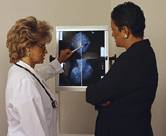
THURSDAY, Dec. 27 (HealthDay News) — The number of Americans seeking cancer screening has declined over the past decade, a new study finds, with less than optimal levels for most types of cancer.
Disagreements among the groups that set screening recommendations, including the U.S. Preventive Services Task Force and American Cancer Society, along with rising numbers of uninsured people, may be influencing the decline in screening rates, the researchers said.
Common screening tests include mammograms for breast cancer, Pap tests for cervical cancer, sigmoidoscopy and colonoscopy for colon and rectal cancers, and prostate-specific antigen blood tests for prostate cancer.
“As Americans, we need to step up to practicing preventive health care, especially for diseases like cancer, where early detection can literally be the difference between life and death,” said lead study author Tainya Clarke, a research associate in epidemiology and public health at the University of Miami Miller School of Medicine.
A large percentage of the general public is still at risk of late stage cancer diagnoses, she said. “The saying ‘early detection saves lives’ is not just a catch phrase,” she said. “Adhering to the screening recommendations of the various governing bodies can improve prognosis and lead to increased treatment options for people who are diagnosed.”
The report was published online Dec. 27 in the journal Frontiers in Cancer Epidemiology and Prevention..
To see if recommended guidelines were being followed, Clarke’s team analyzed cancer screening among nearly 175,000 Americans who took part in the U.S. National Health Interview Survey between 1997 and 2010.
Specifically, they looked at cancer screening rates for colorectal, breast, cervical and prostate cancers, comparing the screening rates in the general public to all cancer survivors and a subgroup of more than 7,500 employed cancer survivors.
They found that most Americans didn’t meet recommended cancer screening goals for most cancers. The exception was colorectal cancer screening — about 54 percent of the general public had colorectal screenings, surpassing the government’s “Healthy People 2010” goal of 50 percent.
Cancer survivors, who are at risk of developing the disease, had higher screening rates and underwent the recommended cancer screenings for all types of cancer except cervical, which decreased to 78 percent over the 10-year period. The study also found that fewer cancer survivors had screenings over the past three years.
Among cancer survivors, white-collar workers had higher screening rates than blue-collar workers.
“You really want to get to the cancer before it gets to you,” Clarke said. “We know white-collar occupations tend to have more options for less strenuous jobs, yet a larger percentage of blue-collar survivors continue to work despite reports of poorer health.”
Policies addressing occupational health and wellness should carefully evaluate approaches to helping jobs accommodate employees with illnesses requiring long-term recovery, Clarke said.
“If your job doesn’t provide paid sick leave and you don’t have long-term disability options, you have to work to survive,” she noted. “Medical bills are one of the leading causes of bankruptcy in the United States. If you want continued access to health insurance for reduced treatment costs, you can’t really quit.”
Dr. Otis Brawley, chief medical officer and executive vice president of the American Cancer Society, said, “Things are going to change dramatically because of the Affordable Care Act.”
“The obstacles to getting screening are going to change over the next several years,” he said. “So think of this study as more of a look back at what was going on in the last 10 years and not a predictor of what might happen in the next 10 years.”
Currently, recommendations differ in terms of how often people should be screened and at what age they should start — or stop — undergoing specific tests. It’s not always clear to patients which tests they need or what their insurance will cover.
In light of the confusion that arises from sometimes conflicting screening protocols, Brawley said it’s good for people to know the risks and benefits of screening.
“The public is starting to get a much better understanding of the fact that there are a series of questions in medicine,” he said. “My view has always been that we should let people be aware of these questions and we should let them decide what they want and respect that decision. There are pluses and minuses associated with every one of these tests.”
More information
To learn more about cancer screening, visit the American Cancer Society.

